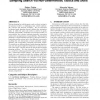Free Online Productivity Tools
i2Speak
i2Symbol
i2OCR
iTex2Img
iWeb2Print
iWeb2Shot
i2Type
iPdf2Split
iPdf2Merge
i2Bopomofo
i2Arabic
i2Style
i2Image
i2PDF
iLatex2Rtf
Sci2ools
ATAL
2009
Springer
2009
Springer
Efficient physics-based planning: sampling search via non-deterministic tactics and skills
Motion planning for mobile agents, such as robots, acting in the physical world is a challenging task, which traditionally concerns safe obstacle avoidance. We are interested in physics-based planning beyond collision-free navigation goals, in which the agent also needs to achieve its goals, including purposefully manipulate non-actuated bodies, in environments that contain multiple physically interacting bodies with varying degrees of controllability. Physics-based planning is computationally hard due to the large number of continuous motion actions and to the difficulty in accurately modeling the rich interactions of such controlled, manipulatable, and uncontrolled, potentially adversarial, bodies. We contribute an efficient physics-based planning algorithm that uses the agent's high-level behaviors to reduce its motion action space. We first discuss the general physics-based planning problem. We then introduce Tactics and Skills as a model for infusing goal-driven, higher leve...
ATAL 2009 | Efficient Physics-based Planning | Intelligent Agents | Physics-based Planning | Physics-based Planning Algorithm |
| Added | 08 Nov 2010 |
| Updated | 08 Nov 2010 |
| Type | Conference |
| Year | 2009 |
| Where | ATAL |
| Authors | Stefan Zickler, Manuela M. Veloso |
Comments (0)

